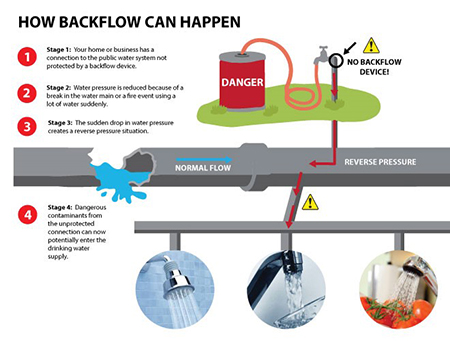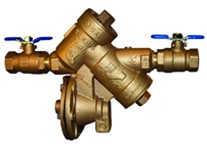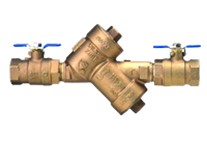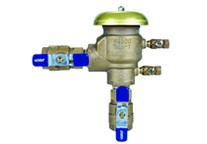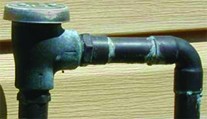Backflow Prevention and Cross-Connection Control Program#
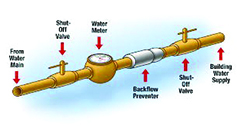
Fort Collins Utilities’ Backflow Prevention and Cross-Connection Control Program protects the public water supply from pollutants and contaminants that could, under certain circumstances, be drawn into the public water supply from private properties. State law requires that a backflow device be installed on any water system that is connected to the drinking water system and carries the potential for cross-contamination.
What is Backflow?
Backflow happens when the normal flow of water is reversed from its intended direction in any pipeline or plumbing system. The danger of backflow comes with the potential for cross-contamination, which is when water that has contacted chemicals or hazardous compounds flows back into the drinking water system.
Commercial, Industrial, Domestic, Irrigation and Fire Lines
All commercial, industrial, domestic, irrigation and fire line services are required to have an approved backflow prevention assembly installed and tested annually.
Residential Properties
Requirements for multi- and single-family residences are assessed based on site hazards. Single-family residential properties are encouraged to hire a certified backflow prevention assembly tester to test their irrigation system every three years.
For homeowners, the most common types of cross-connections include hoses connected at hose bibs, in-ground irrigation systems, private fire sprinkler systems, boiler systems, and pool or pond equipment. The most common residential backflow device is a PVB, or Pressure Vacuum Breaker.
Auxiliary Water Supply or Dual Water Lines
All customers with an auxiliary water supply or dual water lines, such as a well or pond, also are required to install and maintain backflow prevention assemblies.
-
If an unprotected cross-connection is discovered on the property, Fort Collins Utilities will require you to install an approved backflow prevention assembly within 60 days of the survey. We realize that, in some cases, a longer period of time may be required for larger installations. Please email the Cross-Connection Control office at cross-connection@fcgov.com or call 970-416-2249 for approval of any extended periods of time.
It is the customer's responsibility to hire a licensed installer to install a backflow prevention assembly. Upon installation, testing is required to be completed by a certified ABPA (American Backflow Prevention Association) or ASSE (American Society of Sanitary Engineering) tester within 48 hours of installation and send the test report(s) to Fort Collins Utilities. The backflow prevention assembly is required thereafter to be tested annually by a certified backflow prevention assembly tester.
It is at the sole discretion of Fort Collins Utilities Cross-Connection Control office to suspend water service if the premise poses a health risk to the public water supply, when a backflow prevention assembly has not been installed or tested.
If you did not pass inspection or have other questions, please call 970-416-2249.
Backflow and Cross-Connection Requirements The Colorado Department of Public Health and Environment regulates drinking water quality and standards. The Colorado Primary Drinking Water Regulations (Section 11.39) outline Utilities' requirements for backflow prevention and cross-connection control.
In addition to installing an assembly, the water customer must have the assembly tested upon installation and annually thereafter by a certified tester. It’s important to remember that testing of existing and replacement backflow assemblies must be reported to BSI Online, and testing of new installation backflow assemblies should be submitted to Fort Collins Utilities by emailing cross-connection@fcgov.com or mailing to:
Fort Collins Utilities
Attn: Norm Mill
Cross-Connection Control
PO Box 580
Fort Collins, CO 80522
-
Backflow is the unwanted flow of water or other liquids, mixtures, gasses or substances into the drinking water supply.
There are two main ways backflow can occur:- Backsiphonage occurs when there is a negative pressure in the water distribution system, which draws the water from a private water system into the public water system. This can occur at any time, such as during a water main break or during a large firefighting effort.
- Backpressure occurs when the pressure in a private water system exceeds the pressure in the public water distribution lines that can cause normal flow to reverse. A pump used to increase the water pressure within a building’s plumbing system to reach a higher floor might cause this.
-
Cross-connections are actual or potential connections between the public water supply and any other system that could accidentally introduce a contaminant back into the public water supply.
According to the Environmental Protection Agency, cross-connections can be a serious public health hazard, if they do not have adequate backflow prevention assemblies installed. There are numerous, well-documented cases in which cross-connections have been responsible for contamination of drinking water that, when consumed, caused the spread of sickness or disease. -
A backflow prevention assembly is a mechanical valve arrangement designed to prevent the reversal of the flow of water once it has passed through the valve.
Like any mechanical device, a backflow prevention assembly requires maintenance and annual testing. There are different types of backflow prevention assemblies required for different uses and different degrees of hazard.
There are no exemptions or grandfathering in of backflow prevention assembly requirements. -
Backflow prevention assemblies installed within Utilities’ distribution system must be approved by the University of Southern California’s Foundation for Cross-Connection Control and Hydraulic Research, otherwise known as being USC-approved.
Check with your backflow prevention assembly manufacturer or the product specification sheets to verify that the assembly is USC-approved. You must also confirm the assembly is approved in the orientation for which it is being installed (horizontal, vertical-up, vertical-down, etc.). -
Reduced Pressure Principle Assembly (RP)
![]()
An RP is required for most commercial, industrial and irrigation domestic water applications.
Installation requirements:- Install a minimum of 12 inches off the floor and 12 inches away from a wall.
- If the assembly is installed higher than 5 feet off the ground, a permanent platform is required for access and maintenance.
- Adequate drainage is required, as there is a potential for discharge from the unit.
- Protect from freezing.
Double Check Valve Assembly (DC)
![]()
A DC is required for fire lines without antifreeze (except food grade glycerin) or chemical additives and some residential applications. They are not allowed for irrigation systems.
Installation requirements:- Install a minimum of 12 inches off the floor and 12 inches away from a wall.
- If the assembly is installed higher than 5 feet off the ground, a permanent platform is required for access and maintenance.
Pressure Vacuum Breaker (PVB)
![]()
PVBs have historically been used as protection for irrigation systems.Installation requirements:
- Must be installed a minimum of 12 inches above the highest point of use and 12 inches away from a wall.
- Cannot be subjected to continuous backpressure.
Atmospheric Vacuum Breaker (AVB)
![]()
AVBs are generally used as point-of-use devices for a specific, internal plumbing process. Fort Collins Utilities allows existing AVBs being used for single-family residential sprinkler systems. See the Cross-Connection Control Manual for details.
Installation requirements:- Cannot have any valve downstream of the device.
- Must be installed a minimum of 6 inches above the highest point of use and 12 inches away from a wall.
- Cannot be subjected to continuous static line pressure or backpressure or be installed where it would be under pressure for more than 12 hours in any 24-hour period.
-
Per the Colorado Primary Drinking Water Regulations (Section 11.39), Fort Collins Utilities is required to survey water services for potentially hazardous cross-connections, where water could flow from a property into the public water system and compromise the water quality for other customers.
Surveys are completed on:- Commercial property water service lines
- Dedicated irrigation lines
- Fire lines
- Multi-family residential water service lines (depending on the degree of hazard)
- Single-family residential water service lines with an auxiliary water supply, such as a well or pond, and home business (depending on the degree of hazard identified)
- Recycled water service lines, if the plumbing system includes chemical injection or pumps
Did You Know?
You can monitor your energy and water use with our online portals.
Fertilizer encourages grass to grow, requiring more water. Use it lightly.
To keep your dryer working at its best, make sure its vent pipe is not kinked or blocked.
